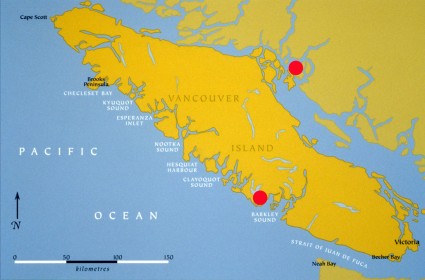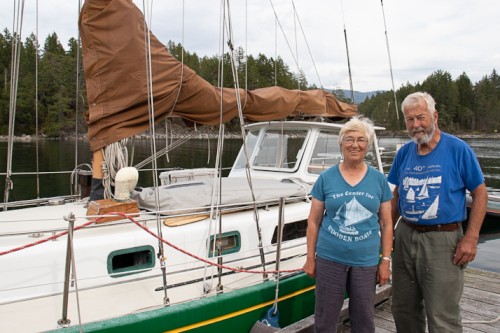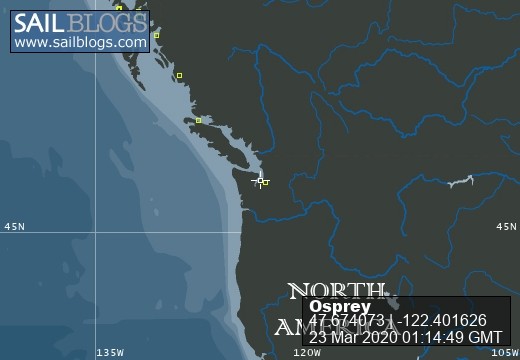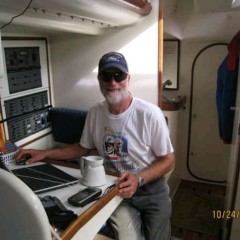Voyages North
23 July 2023
21 August 2021
11 July 2021 | Posted in Seattle
16 May 2021
07 January 2021
10 April 2020 | Posted in Seattle
31 August 2019 | Posted at Port McNeill
31 August 2019
30 August 2019
30 August 2019 | Posted at Port MCNeill
13 August 2019 | Posted at Prince Rupert
13 August 2019 | Posted at Prince Rupert
03 August 2019 | Posted at Ketchikan
02 August 2019 | Posted at Metlakatla
02 August 2019 | posted in Metlakatla AK
22 July 2019 | Posted at Klawock/Craig
22 July 2019 | Posted at Klawock/Craig
09 July 2019 | Posted at Juneau
09 July 2019 | Posted at Juneau
27 June 2019
West Coast of Vancouver Island: The Windward Route
23 January 2012
Elsie Hulsizer

So you want to take your boat to one of the best cruising grounds in the Pacific Northwest! Maybe you've read my book, Voyages to Windward: Sailing Adventures on Vancouver Island's West Coast, and were entranced by the stories of isolated anchorages, picturesque villages, gorgeous scenery and interesting wildlife. Or maybe you read my most recent blog on what a great preparation the West Coast of Vancouver Island can be for a trip to SE Alaska.
But then you got out your chart. "Wait a minute," you probably said. "I have to go out Juan de Fuca Strait? I have to go out in the ocean? Whoa!"
The Seattle Boat Show is coming up and in my seminars there I give some tips for getting there with the least amount of anguish. It's not as bad as it looks. I've noticed that my audiences take lots of notes during the how-to part of my presentation. So I thought I would help by putting the meat of what I say on this blog.
First, you may be surprised to learn that Hot Springs Cove at the northern end of Clayoquot Sound, the West Coast's second sound going north, is no farther than Desolation Sound on the inside. Barkley Sound, that most favorite of West Coast Vancouver Island destinations is significantly closer. The distance is more psychological than geographic.

Red dots show Desolation Sound and Barkley Sound.
Some of that psychological distance comes from the prevailing wisdom which is that you should get to the West Coast of Vancouver Island by going around the island so you can have the wind behind you on the rough outer coast. All the guidebooks present the coast from north to south. Fine if you have the whole summer, but what if you have only three weeks or want to spend all your time on the west coast of Vancouver Island, not circumnavigating.
Ignore the prevailing wisdom -- the best way to explore the West C of VI is to sail directly there by going to windward. The advantages are:
See the best part coming and going
Avoid Cape Scott and the Brooks Peninsula
Get there and back in a two or three week vacation
Tips for getting there.
My husband Steve and I have made 17 trips to Windward to the West Coast of Vancouver Island (and another 4 trips approaching from the north from either Haida Gwaii or SE Alaska). After 17 trips, we've learned a few things to make that windward trip a bit easier. They apply especially to sailboats but to slower powerboats also.
• Avoid the worst fog by going in July.
When leaving from the Puget Sound area:
• Plan your trip to depart on a spring tide weekend. The best Saturdays to leave in 2012 will be June 30 and July 14.
• Leave the dock just before slack-before-the-ebb. Most years the best tides are in the middle of the night or early morning. That puts you in the Strait of Juan de Fuca in the morning when the winds are light.
• Once you enter the Strait, go out the American side. The ebb lasts longer on the American side and there are better anchorages. If you want to include Victoria in your trip, do it on the way back home when you have already gone through customs.
• Anchor at Pillar Point the first night. The curve of land protects from swell. Wind in summer blows from West. (faster powerboats can go all the way to Neah Bay). A small swell can get in there and, of course, if you get one of those rare winds from the east, all bets are off and you should skeedattle for Neah Bay--which should be easy because the winds in that case will be behind you. This is a spectacular anchorage, an adventure all its own. Read more about it in my article from 48 North.
• Get up early again (but not as early as the day before and catch the ebb out the strait. But now you should cut across the Strait and make your final approach to Barkley Sound from the Canadian side. This avoids the tide rips and rough water off Neah Bay and puts you inside Swiftsure Bank.
An alternate route for slower boats, or for any boat during neap tides is to go to Port Angeles the first night, Pillar Point the second, Neah Bay the third. The crossing from Neah Bay will be shorter but rougher.
• Go through customs at Ucluelet
When leaving from Canadian ports.
For Canadian boats coming from Vancouver, the choice of outside vs inside is not as clear. You will have approximately 2-3 days additional travel when leaving from Vancouver. It's still shorter than circumnavigating, but not by as much. Canadian boats leaving from the Victoria area, or those coming from Vancouver once they reach the Victoria area, have different choices to make. Following my advice about going out the American side and anchoring at Pillar Point doesn't make sense as it means going through both American and Canadian customs.
The advice about leaving on a spring tide weekend still holds.
The anchorages on the Canadian side are not as good as the American side. One option is to anchor over night at Sooke or Becher Bays near Victoria, then get up early and travel from there all the way to Bamfield. Since you don't need to go to Ucluelet for customs, you have a somewhat shorter trip. Otherwise you are stuck with Port San Juan. The marina there holds only small resident boats and the anchorages are rolly. In their Dreamspeaker Cruising Guide: The West Coast of Vancouver Island Including Bunsby Islands and the Broken Group , the Yeadon-Jones recommend several nooks for anchoring in this open bay, all of which could be classified as good weather anchorages only. If the wind comes up strong from the south, you can claim harbor of refuge in Neah Bay but you will need to go through American customs then back through Canadian customs at Ucluelet if you do that.
• Whether you came from the U.S. or Canada, once on the West Coast of the island, you should travel north inside the sounds as much as you can. That keeps you in protected waters. Watch the weather before making an ocean passage.
• The exception to that advice is if the wind turns from the south. In that case, stay in the ocean and head north as far as you can, then take your time going south.
Tips for the Return Trip
• Take the ocean route down the island to Barkley Sound if the wind is from northwest. By staying out in the ocean and skipping some of the sounds on the way home, what took you a week going north can be done in a day or two going south.
• Leave enough time to wait out a storm.
• Make one long trip from Barkley Sound to Becher Bay or to Port Angeles. The current floods longer on Canadian side. If possible, time your entry into the Strait for slack before flood.
Once you are on the west coast of Vancouver Island a wonderful cruising ground of five major sounds and inlets is available to you. To find out more about all these wonderful places, be sure to take your copy of Voyages to Windward: Sailing Adventures on Vancouver Island's West Coast with you.
But then you got out your chart. "Wait a minute," you probably said. "I have to go out Juan de Fuca Strait? I have to go out in the ocean? Whoa!"
The Seattle Boat Show is coming up and in my seminars there I give some tips for getting there with the least amount of anguish. It's not as bad as it looks. I've noticed that my audiences take lots of notes during the how-to part of my presentation. So I thought I would help by putting the meat of what I say on this blog.
First, you may be surprised to learn that Hot Springs Cove at the northern end of Clayoquot Sound, the West Coast's second sound going north, is no farther than Desolation Sound on the inside. Barkley Sound, that most favorite of West Coast Vancouver Island destinations is significantly closer. The distance is more psychological than geographic.

Red dots show Desolation Sound and Barkley Sound.
Some of that psychological distance comes from the prevailing wisdom which is that you should get to the West Coast of Vancouver Island by going around the island so you can have the wind behind you on the rough outer coast. All the guidebooks present the coast from north to south. Fine if you have the whole summer, but what if you have only three weeks or want to spend all your time on the west coast of Vancouver Island, not circumnavigating.
Ignore the prevailing wisdom -- the best way to explore the West C of VI is to sail directly there by going to windward. The advantages are:
See the best part coming and going
Avoid Cape Scott and the Brooks Peninsula
Get there and back in a two or three week vacation
Tips for getting there.
My husband Steve and I have made 17 trips to Windward to the West Coast of Vancouver Island (and another 4 trips approaching from the north from either Haida Gwaii or SE Alaska). After 17 trips, we've learned a few things to make that windward trip a bit easier. They apply especially to sailboats but to slower powerboats also.
• Avoid the worst fog by going in July.
When leaving from the Puget Sound area:
• Plan your trip to depart on a spring tide weekend. The best Saturdays to leave in 2012 will be June 30 and July 14.
• Leave the dock just before slack-before-the-ebb. Most years the best tides are in the middle of the night or early morning. That puts you in the Strait of Juan de Fuca in the morning when the winds are light.
• Once you enter the Strait, go out the American side. The ebb lasts longer on the American side and there are better anchorages. If you want to include Victoria in your trip, do it on the way back home when you have already gone through customs.
• Anchor at Pillar Point the first night. The curve of land protects from swell. Wind in summer blows from West. (faster powerboats can go all the way to Neah Bay). A small swell can get in there and, of course, if you get one of those rare winds from the east, all bets are off and you should skeedattle for Neah Bay--which should be easy because the winds in that case will be behind you. This is a spectacular anchorage, an adventure all its own. Read more about it in my article from 48 North.
• Get up early again (but not as early as the day before and catch the ebb out the strait. But now you should cut across the Strait and make your final approach to Barkley Sound from the Canadian side. This avoids the tide rips and rough water off Neah Bay and puts you inside Swiftsure Bank.
An alternate route for slower boats, or for any boat during neap tides is to go to Port Angeles the first night, Pillar Point the second, Neah Bay the third. The crossing from Neah Bay will be shorter but rougher.
• Go through customs at Ucluelet
When leaving from Canadian ports.
For Canadian boats coming from Vancouver, the choice of outside vs inside is not as clear. You will have approximately 2-3 days additional travel when leaving from Vancouver. It's still shorter than circumnavigating, but not by as much. Canadian boats leaving from the Victoria area, or those coming from Vancouver once they reach the Victoria area, have different choices to make. Following my advice about going out the American side and anchoring at Pillar Point doesn't make sense as it means going through both American and Canadian customs.
The advice about leaving on a spring tide weekend still holds.
The anchorages on the Canadian side are not as good as the American side. One option is to anchor over night at Sooke or Becher Bays near Victoria, then get up early and travel from there all the way to Bamfield. Since you don't need to go to Ucluelet for customs, you have a somewhat shorter trip. Otherwise you are stuck with Port San Juan. The marina there holds only small resident boats and the anchorages are rolly. In their Dreamspeaker Cruising Guide: The West Coast of Vancouver Island Including Bunsby Islands and the Broken Group , the Yeadon-Jones recommend several nooks for anchoring in this open bay, all of which could be classified as good weather anchorages only. If the wind comes up strong from the south, you can claim harbor of refuge in Neah Bay but you will need to go through American customs then back through Canadian customs at Ucluelet if you do that.
• Whether you came from the U.S. or Canada, once on the West Coast of the island, you should travel north inside the sounds as much as you can. That keeps you in protected waters. Watch the weather before making an ocean passage.
• The exception to that advice is if the wind turns from the south. In that case, stay in the ocean and head north as far as you can, then take your time going south.
Tips for the Return Trip
• Take the ocean route down the island to Barkley Sound if the wind is from northwest. By staying out in the ocean and skipping some of the sounds on the way home, what took you a week going north can be done in a day or two going south.
• Leave enough time to wait out a storm.
• Make one long trip from Barkley Sound to Becher Bay or to Port Angeles. The current floods longer on Canadian side. If possible, time your entry into the Strait for slack before flood.
Once you are on the west coast of Vancouver Island a wonderful cruising ground of five major sounds and inlets is available to you. To find out more about all these wonderful places, be sure to take your copy of Voyages to Windward: Sailing Adventures on Vancouver Island's West Coast with you.
Comments
| Vessel Name: | Osprey |
| Vessel Make/Model: | Annapolis 44 sloop |
| Hailing Port: | Seattle |
| Crew: | Steve and Elsie Hulsizer (author of Glaciers, Bears and Totems and Voyages to Windward) |
| About: | |
| Extra: |
Osprey's Photos - Main
No items in this gallery.
Voyages North on SV Osprey

Who: Steve and Elsie Hulsizer (author of Glaciers, Bears and Totems and Voyages to Windward)
Port: Seattle


